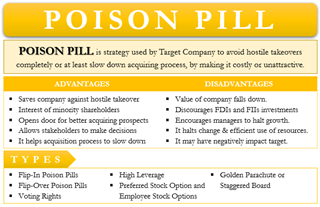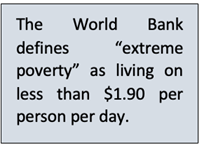Tuesday, 19th April 2022
Global Traditional Medical Systems
In News
The Prime Minister along with the Director-General of the World Health Organization (WHO) will be laying the foundation stone for Global Centre for Traditional Medicine (GCTM) at Jamnagar in Gujarat.
About the News
- It will be the first-of-its-kind and the only Centre for Traditional Medicine in the world.
- GCTM will emerge as an international hub of global wellness and will focus on spreading across the world, the rich heritage of ancient medicine, and social-cultural diversity of different regions.
- It aims to focus on evidence-based research, innovation, and data analysis to optimise the contribution of traditional medicine to global health.
- The centre will collect data relating to the analysis of the alternative medicines as well as will be helpful in conducting assessment on quality, safety, effectiveness and convenience for administration of the traditional medicines.
- Its main focus will be to develop norms, standards and guidelines in technical areas relating to traditional medicine and help countries create a comprehensive, safe, and high-quality health system.
- The GCTM will support efforts to implement the WHO’s Traditional Medicine Strategy (2014-23), which aims to support nations in developing policies & action plans to strengthen the role of traditional medicine in pursuing the goal of universal health coverage.

Need to advance knowledge of traditional medicine: WHY?
- According to WHO, 170 of its 194 WHO Member States have reported the use of traditional medicine.
- Added to this, about 40% of approved pharmaceutical products today are derived from natural substances.
- For example, the discovery of aspirin drew on traditional medicine formulations using the bark of the willow tree, the contraceptive pill was developed from the roots of wild yam plants and child cancer treatments have been based on the rosy periwinkle.
- Thirdly, there is modernization of the ways traditional medicine is being studied. Artificial intelligence is now being used to map evidence and trends in traditional medicine.
- For instance, Functional magnetic resonance imaging is used to study brain activity and the relaxation response that is part of some traditional medicine therapies such as meditation and yoga, which are increasingly drawn on for mental health and well-being in stressful times.
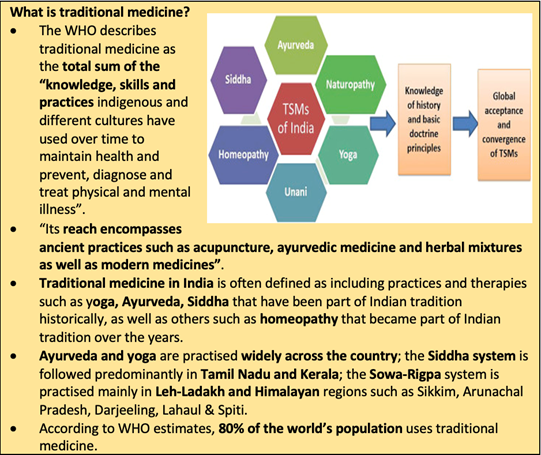
India’s Efforts to Enhance the use of Traditional Medicine:
- In 2016, the Ministry of AYUSH signed a project collaboration agreement (PCA) with the WHO in the area of traditional medicine with the aim to create benchmarks for training in yoga, Ayurveda, Unani and Panchakarma, for traditional medicine practitioners.
- At least 32 MoUs for undertaking collaborative research and development of traditional medicine have been signed with institutes, universities and organisations from the US, Germany, UK, Canada, Malaysia, Brazil, Australia, Austria etc,.
- A constituent laboratory of the Council of Scientific & Industrial Research- Institute of Himalayan Bio-resource Technology (CSIR-IHBT) has signed an MoU with National Research Institute of Chinese Medicine, Taiwan, to collaborate in areas of medicinal plants, bioactive molecules, herbal formulations etc.
- The CSIR and the Bill & Melinda Gates Foundation have also signed an MoU to identify opportunities for scientific and technological research between researchers within and outside India.
Source:
- Explained: WHO & traditional medicine
- In Gujarat, WHO to start a new chapter in global traditional medical systems
Image source:
Pyramid scheme case against Amway
In News
The Enforcement Directorate (ED) recently attached assets worth ₹757.77 crore belonging to FMCG Amway India in money laundering case.
About the News
- A money laundering probe by ED had revealed that Amway is running a pyramid fraud in the guise of direct selling multi-level marketing network creating a multi-level marketing scam.
- According to the agency, the company has collected an amount of Rs 27,562 crore from its business operations between 2002-03 and 2021-22. Of this, it paid commission of Rs 7,588 crore to its distributors and members in India and in the US during this period.
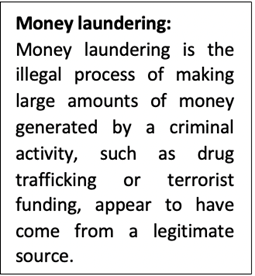
What is a Pyramid Scheme?
- A pyramid scheme is a dubious and unsustainable business model, where a few top-level members recruit newer members.
- Those members pay upfront costs up the chain to those who enrolled them.
- As newer members in turn recruit underlings of their own, a portion of the subsequent fees they receive is also kicked up the chain.
- The vast majority of pyramid schemes rely on profiting from recruitment fees and seldom involve the sale of actual goods or services with intrinsic value.
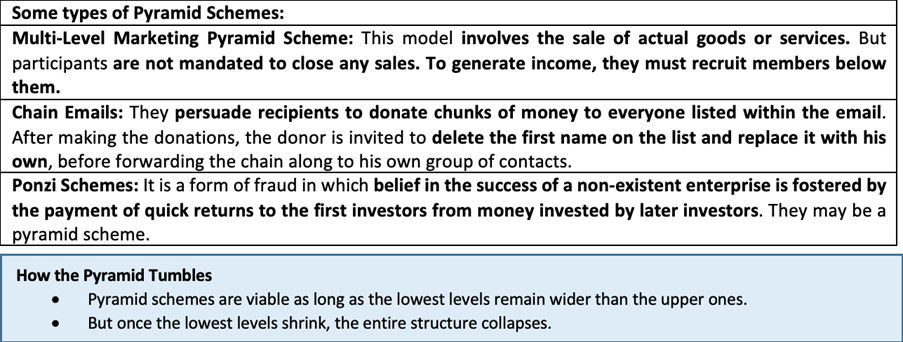
Rules in India
- Under Consumer Protection Rules, 2021, all direct selling companies and sellers are prohibited from promoting a pyramid scheme or enrolling any person on such scheme or participating in such arrangement, in any manner whatsoever, in the garb of doing direct selling business or participating in money circulation scheme in the garb of doing direct selling business.
- It is made mandatory for direct selling entities to register themselves—like incorporation under the Companies Act, 2013, or under the Partnership Act, 1932, or under the Limited Liability Partnership Act, 2008.
- It is also now mandatory to have a minimum of one physical location as its registered office within India and the companies to make a self-declaration that a direct selling entity has complied with the provisions of the direct selling rules.
- They must establish a mechanism for filing complaints by consumers through its offices or branches or direct sellers, either in person or through the post, telephone, e-mail or website
- They must maintain a record of all its direct sellers, including their identity proof, address proof, e-mail and other such information, and such list must be publicly shared on its website.
- They must ensure that the advertisements for marketing of goods or services are consistent with the actual characteristics, access and usage conditions of such goods or services.
Sources:
State sponsor of terrorism
In News
Ukraine’s President has asked US President to designate Russia as a “state sponsor of terrorism.
About the News
- The designation would activate perhaps the harshest suite of sanctions available with the United States against the government of Russia.
- Although USA has not committed to same but if designated, it would deal blows to Russia’s reputation.
What does designation as a ‘state sponsor of terrorism’ by the US mean?
- Authority to designate: The US Secretary of State (the minister primarily in charge of foreign relations) has the power to designate countries that “have repeatedly provided support for acts of international terrorism” as “State Sponsors of Terrorism”.
- Objectionable activities: All activities that the Secretary determines as wilfully aid or abet the international proliferation of nuclear explosive devices, help in acquiring unsafeguarded special nuclear material, or to use, develop, produce, stockpile, or otherwise acquire chemical, biological, or radiological weapons to individuals or groups
- Identification: Arms Export Control Act (AECA), which prohibits exports, credits, guarantees, other financial assistance, and export licensing overseen by the State Department identifies objectionable activities as part of the definition.
- Types of Sanctions: The US can place four categories of sanctions on countries that are on this list: restrictions on US foreign assistance; a ban on defence exports and sales; certain controls over exports of dual use items; and miscellaneous financial and other restrictions.
- Trading countries: Sanctions can also be placed on countries and persons that engage in certain trade with designated countries.
- Countries on list: As of now, there are four countries on the list of state sponsors of terrorism including Syria, Iran, North Korea and Cuba in 2021.
- Not one time affair: Countries can be put and taken off the list from time to time. A country can be de-listed if it is deemed by the US to have reformed its behaviour and returned to complying with the requirements of international law and conduct, or undergone a change of leadership.

What are the implications of this designation?
- Psychological impact: Adding Russia to the state sponsors of terrorism list would be the nuclear economic option and a precision strike against Russia’s ego.
- Financial impact: Designation can potentially hurt the target country’s financial system including:
- Freezing of the country’s assets in the United States, including real estate;
- Requiring the US to veto efforts of that country to secure World Bank or International Monetary Fund loans;
- Prohibiting a wide variety of dual-use exports;
- Requiring the US to take economic action against countries that continue to do business with the targeted country.”
Sources:
Krishnaji Gopal Karve
On April 19, 1910, Krishnaji Gopal Karve breathed his last. Krishnaji Gopal Karve was an Indian freedom fighter and a revolutionary. Born in Nashik in 1887, he completed his B.A. (Hons) and took admission to LLB in Mumbai University. He was popularly called Anna Karve. He was a member of the Abhinav Bharat Society in Nashik. On 21 December 1909, he along with Anant Laxman Kanhere shot Jackson, the Collector of Nashik. He was sentenced to death in the Bombay high court and hanged in Thane Jail on 19th April 1910.

Source:
India's Demographic Dividend
In News
The Confederation of Indian Industry (CII) has released a report on India's Demographic Dividend.
Introduction
- As defined by the United Nations Population Fund (UNFPA), the demographic dividend is the economic growth potential that can result from shifts in a population’s age structure, mainly when the share of the working-age population (15 to 64) is larger than the non-working-age share of the population (14 and younger, and 65 and older).
- The CII report has highlighted that the demographic dividend of India will become a liability if the country does not produce enough jobs and required workforce.
- India will add another 183 million people to the working age group of 15-64 years between 2020-50 as per the UN Population Statistics database. Thus, a whopping 22% of the incremental global workforce over the next three decades will come from India.
- The report warns that there is an acute shortage of time and that India's working age population is necessary but not sufficient for it to sustain the economic growth.
Status of India’s Demography
- With falling fertility (currently 2.0), rising median age (from 24 years in 2011, 29 years now and expected to be 36 years by 2036), a falling dependency ratio (expected to decrease from 65% to 54% in the coming decade taking 15-59 years as the working age population), India is in the middle of a demographic transition.
- This provides a window of opportunity towards faster economic growth. India has already begun to get the dividend. In India, the benefit to the GDP from demographic transition has been lower than its peers in Asia and is already tapering. Hence, there is an urgency to take appropriate policy measures.
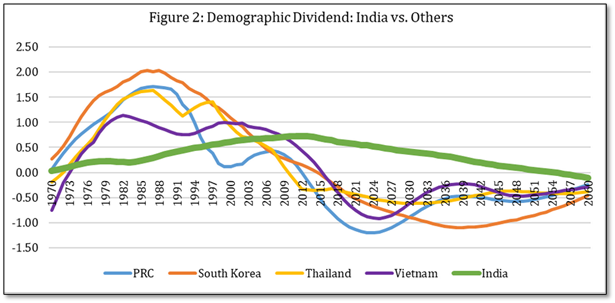
Relation between Demographic Dividend and Economic Growth
- India’s demographic profile should increase growth through five distinct forces.
- The first is the swelling of India’s labour force as its baby boomers reach working age.
- The second is the potential to divert resources from spending on children to investing in physical and human infrastructure.
- The third is a rise in women’s workforce activity that naturally accompanies a decline in fertility.
- The fourth is that working ages also happen to be the prime years for savings, which is key to the accumulation of capital and technological innovation.
- The fifth is the further boost to savings that occurs as the incentive to save for longer periods of retirement increases with greater longevity.
- India’s least economically developed states (Bihar, Uttar Pradesh, Madhya Pradesh, and West Bengal) will benefit the most from that demographic dividend. India is at a point in its demographic transition where a focus on the policy environment will maximize the chance of capturing the benefits.
Sense of Urgency to harness Demographic Dividend
The CII Report says that India does not have much time to utilise this dividend.
- As per the report, while we are likely to add 101 million people in the working age population between 2020-30, this number will reduce to 61 million and then to 21 million for 2030-40 and 2040-50, respectively. It is expected that India's working age population will start declining in the decade post 2050.
- Thus, 2020-50 provides India with a short window of opportunity to harness its demographic dividend.
- The report also analyses India's labour market imbalances, and highlights how the skill mismatch and shortage can impact productivity growth, which is critical for India to enhance its long-term growth. In 2019-20, only 73 million of India's 542 million strong workforce received any form of vocational training (whether formal or informal).
- To put it in global context, the proportion of formally skilled workers as a percentage of total workforce stands at 24% in China, 52% in USA, 68% in UK and 80% in Japan, against a paltry 3% in India.
- The report said that high quality school education, relevant higher education and skill development aligned to industry needs are some of the pre-requisites, if India is to become an economic powerhouse which not only creates good quality jobs for its youth, but also services the rest of the world.
Reaping India’s demographic dividend
- Invest more in children and adolescents: India needs to invest more in children and adolescents, particularly in nutrition and learning during early childhood. Given that India’s workforce starts at a younger age, a greater focus needs to be on transitioning from secondary education to universal skilling and entrepreneurship, as done in South Korea.
- Make health investments: The public spending on health has remained flat at around 1% of GDP. Evidence suggests that better health facilitates improved economic production.
- Make reproductive healthcare services accessible on a rights-based approach: We need to provide universal access to high-quality primary education and basic healthcare. The unmet need for family planning in India at 9.4% as per the latest National Family Health Survey-5 (2019-21) is high as compared to 3.3% in China and 6.6% in South Korea, which needs to be bridged.
- Education is an enabler to bridge gender differentials: The gender inequality of education is a concern, which needs to be reversed. In the Philippines, China, and Thailand, it is the reverse. In Japan, South Korea, and Indonesia, the gender differences are rather minimal..
- India needs to increase female workforce participation in the economy. As of 2019, 3% of women were working or looking for work, down from 34.1% in 2003-04. New skills and opportunities for women and girls befitting their participation in a $3 trillion economy is urgently needed.
- It is predicted that if all women engaged in domestic duties in India who are willing to work had a job, female labour force participation would increase by about 20%.
- India needs to address the diversity between States: While India is a young country, the status and pace of population ageing vary among States. Southern States, which are advanced in demographic transition, already have a higher percentage of older people.
- These differences in age structure reflect differences in economic development and health. But this also offers boundless opportunities for States to work together, especially on demographic transition, with the north-central region as the reservoir of India’s workforce.
Conclusion: A new federal approach to governance reforms for demographic dividend will need to be put in place for policy coordination between States on various emerging population issues such as migration, ageing, skilling, female workforce participation and urbanisation. Inter-ministerial coordination for strategic planning, investment, monitoring, and course correction should be an important feature of this governance arrangement.
Question: The demographic dividend of India will become a liability if the country does not produce enough jobs and required workforce. Elaborate.
Sources:
- Can India's demographic dividend turn into liability?
- India's demographic dividend stares at becoming liability if enough jobs not produced by 2050: CII
- Demographic dividend may turn into liability sans enough jobs, skilled workforce: Report
- Indian Demography and Capitalization of its Demographic Dividend:A Comparative Assessment
- What Is the Demographic Dividend?
- Reaping India’s demographic dividend
- India must make the most of its demographic dividend
- Fact Sheet: Attaining the Demographic Dividend
- Demographic dividend:
- Harnessing India’s Demographic Dividend:
Singaperumal Koil
This is image of Singaperumal Koil, located around 45 km from the Chennai, has an ancient cave shrine to Narasimha. The sanctum at Singaperumal Koil is built around the large carved Narasimha, attributed to the Pallavas and dating to around the eighth century. On either side of the Narasimha sanctum are shrines to Ahobilavalli, Andal, Lakshmi Narasimha and Vishwaksena. Surviving inscriptions reveal that the deity here was known as Narasinga Vinnagar Deva or Azhwar. The earliest such writings here pertain to the era of Raja Raja I (r 985-1014AD) and speak of local rather than royal patronage. The temple received support also from the Vijayanagar and Nayak kings.
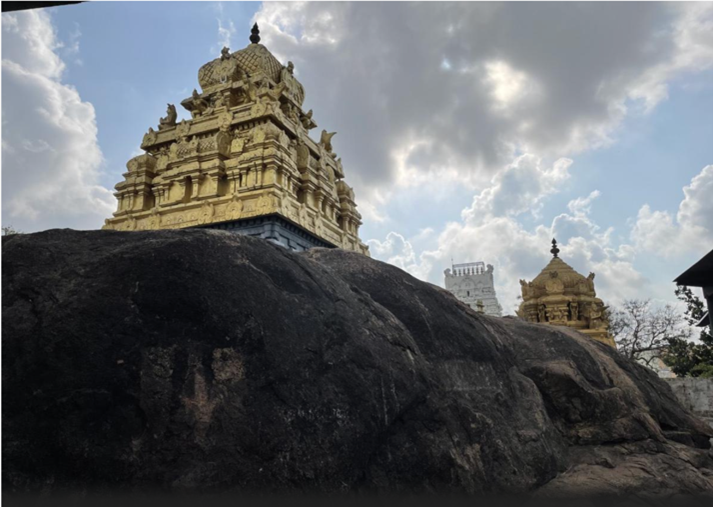
Source:
Positive indigenisation list - Edukemy Current Affairs
- Context: The Defence Minister recently released the third positive indigenisation list of 101 equipment and platforms.
- The list includes naval utility helicopters, light tanks, small Unmanned Aerial Vehicles, anti-ship missiles among others.
- It essentially means that the Armed Forces—Army, Navy and Air Force—will only procure all of these 101 items from domestic manufacturers. The manufacturers could be private sector players or defence Public Sector Undertakings (DPSUs).
- These measures were meant to incentivise the private sector to invest in defence manufacturing, which would also build competition for the Defence Public Sector Undertakings (DPSU) improving their efficiency. In this direction, the government recently corporatised the Ordnance Factory Board and converted it into seven DPSUs.
- Of the ₹52 lakh crore capital allocation in this year’s Defence budget, which was meant for new purchases and payments for past procurements, 68% from the allocation for the three Services had been reserved for procurement from the domestic industry.

Source:
Enforcement Directorate (ED)
- Context: Powers of the ED under the Prevention of Money Laundering Act.
- The ED is a multi-dimensional organisation that investigates economic offences under the Prevention of Money Laundering Act (PMLA), Fugitive Economic Offenders Act, Foreign Exchange Management Act and
- It came into existence in 1956, when an ‘Enforcement Unit’ was formed in the Department of Economic Affairs, for handling Exchange Control Laws violations under the Foreign Exchange Regulation Act (FERA).
- The ED gets its power from the PMLA to investigate under Sections 48 (authorities under act) and 49 (appointment and powers of authorities and other officers).
- The PMLA was enacted in 2005 to prevent parking of the money outside India and to trace out the layering and the trail of money.
- Whenever any offence is registered by a local police station, which has generated proceeds of crime over and above ₹1 crore, the investigating police officer forwards the details to the ED.
- The ED also carries out search (property) and seizure (money/documents) after it has decided that the money has been laundered, under Section 16 & Section 17 of the PMLA.
- It can also directly carry out search and seizure without calling the person for questioning.
- The ED is headquartered in New Delhi headed by the Director of Enforcement and has five regional offices at Mumbai, Chennai, Chandigarh, Kolkata and Delhi headed by special directors of Enforcement.
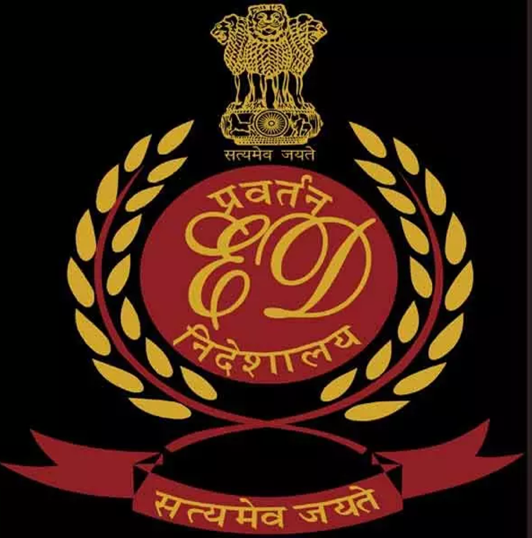
Source:
Image source:
New shrimp species: ‘Actinimenes Koyas’
- Context: Scientists from the ICAR-National Bureau of Fish Genetic Resources (NBFGR), have recently discovered a new species of shrimp, which has been named Actinimenes koyas.
- This new species has been named ‘Koyas’ to honour the local community on the Lakshadweep islands as Koyas form an important ethnic community on the islands, who have made a significant contribution to the development and preservation of the heritage of the society.
- The species has been collected at a depth of 0–2.0 m from the coral atoll of Agatti Island, which is part of the Lakshadweep group of islands.
- It is closely related to some other shrimp species in morphological traits and is easily distinguished from the other species by the structural variation in the fourth sternal plate with a median notch.

Source:
Image source:
Singapore formula
- Context: In the backdrop of Traffic exasperation being back to pre-pandemic levels in India, adopting Singapore formula of road rationing would help India to efficiently handle its Traffic load.
- Singapore’s mixed model combines market devices with a licence raj.
- Not only does it charge for street usage, but with the dynamic pricing of routes acting as a live decongestant, it caps the aggregate number of vehicles
- Licence holders squat on their right to own a car, while the few licences released every now and then get costlier as demand rises.
- Indian metropolitan traffic too could do with some experiments in road pricing, enabled by satellite-linked software systems.
- However, car licences would be far too elitist, especially if the system favours the status quo and erects rising barriers for aspirants.
- For all this, India needs green and efficient public transport options first.

Source:
Image source:
The long road ahead to population immunity: Hindustan Times
Essence: As per the author, covid-19 pandemic is not over, and virus is mutating and escaping immunity, whenever possible and lifting of all restrictions is helping it spread rapidly. Populations which are neither previously infected, nor fully vaccinated are currently at high risk of getting severe symptoms.
India has reported fewer deaths and minimally symptomatic cases during Omicron wave due to hybrid immunity of its population, as nearly 80% of its population are previously infected and due to greater coverage of its vaccination programme. However, in recent times, there has been increase in infections due to removal of restrictions and decrease in immunity. Thus, it is important to keep track of new variants that may further increase transmissibility or virulence. We need high quality sequencing and analysis of raw sequencing data for surveillance of new variants and to give early warning of next wave.
Why should you read this article?
- To understand the mutations, variants and situation of covid-19 in the present times.
- To know about the factors that determine the risk profile of the population to severe covid infection.
- To know about the situation of India and the authors suggestion to keep infections low.
Source:
India can criticize Russia’s Ukraine Invasion: The Hindu
Essence: The editorial talks about increasing strength of India’s diplomacy and rise in its stakes in international domain in the last few years. Few years back, India was forced to cut its oil supplies and rethink its ties with Iran and a similar course is being charted for India by USA. While India has pushed back such demands, it has increased its energy imports from Russia, abstained on many UN votes against Russia, continued its defense trade with Russia and looks forward to circumventing sanctions through Rupee-Rouble payments.
This pro-Russian stand arises from the perception of future challenges- defense and energy procurements, challenges with its continental partners (China, Pakistan) and alleged human rights violations against people and press in the country- Russia plays a role in each instance. Russia caters to defense spare parts imports to India, transfer of technology for defense, nuclear, Arctic exploration, India’s ownership of energy fields in Russia, etc. Russia as a permanent member of UNSC with its veto power, influence in groupings like BRICS, SCO, support to India at multilateral institutions like FATF and NSG- all these contribute to pull factors towards Russia.
All these are indications towards principles of non-alignment and strategic autonomy. Just like India previously criticized USA of its attack on Iraq without UNSC consonance, India could deplore Russia’s war on Ukraine despite being a friend. The assertion of strategic autonomy cannot carry credibility, unless it is expressed without fear or favor of the consequences.
Why should you read this article?
- To know about the support that Russia provides to India in multiple ways.
- To understand the deeper meaning of strategic autonomy in reference to international events and issues.
Source:
How the IAS has fared well in service to the nation: LiveMint
Essence: The editorial charts out the areas of improvement for performance of Indian bureaucracy, especially the Indian Administrative Service. While IAS officers’ track record has been fairly impressive in the way Constitution envisaged, reflected through income, health, educational attainments of the people, the task is still unaccomplished.
In the process of evolution of democracy, the IAS cadre needs to evolve as well to gain the fabled “competence, commitment and integrity” to work. Post emergency, there was an increase in trend to reward pliable officers, in favor of ruling party, the nature of recruits changed in the past 30 years and globalization offered lucrative private jobs. The IAS has not been a cohesive unit protecting and defending its turf for public good, unlike courts and legislature. IAS officers are vulnerable to post retirement benefits, illegitimate political interference, reputation-ruining by media, etc.
Reforms are needed from within IAS cadre and at institutional level but work of the steel pillars of democracy (bureaucracy), acting in the benefit on people and nation can’t be underestimated.
Why should you read this article?
- To know about the various reforms required in IAS cadre.
- To understand the evolution and composition of bureaucracy since independence.
Source:
Bridging the Gender Divide
Background
In the past, it has been shown that adolescent girls are more likely to drop out when schools are closed in crisis situations. As a result, the gender divide in education, early and forced marriages, early pregnancy, and other social outcomes widen.
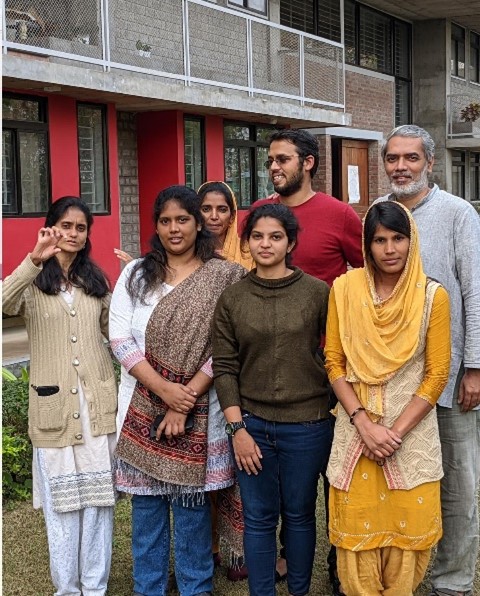
How SwaTaleem is bridging the gap?
- Swa Taleem ensures that girls in Haryana, particularly those from under-represented communities, have access to education.
- SwaTaleem is a word that means "own your education." The name is a combination of the Sanskrit Swa (which means "your own") and the Urdu Taleem (which means "your own") (education).
- Since 2018, the organisation has been working to educate girls and is a recipient of the org Impact Challenge for Women and Girls 2021.
- SwaTaleem, founded by Ashoka Young India Fellows Ananya Tiwari and Vaibhav Kumar, uses an Interactive Voice Response System (IVRS) to help bridge the gender divide in education, particularly among under-represented communities in Haryana.
- During the pandemic, more than half of the parents confirmed that their daughters remained engaged in their education.
Quote: “Achieving gender equality requires the engagement of women and men, girls and boys. It is everyone’s responsibility.”- Ban Ki-Moon.
Source:
Share the article
Get Latest Updates on Offers, Event dates, and free Mentorship sessions.

Get in touch with our Expert Academic Counsellors 👋
FAQs
UPSC Daily Current Affairs focuses on learning current events on a daily basis. An aspirant needs to study regular and updated information about current events, news, and relevant topics that are important for UPSC aspirants. It covers national and international affairs, government policies, socio-economic issues, science and technology advancements, and more.
UPSC Daily Current Affairs provides aspirants with a concise and comprehensive overview of the latest happenings and developments across various fields. It helps aspirants stay updated with current affairs and provides them with valuable insights and analysis, which are essential for answering questions in the UPSC examinations. It enhances their knowledge, analytical skills, and ability to connect current affairs with the UPSC syllabus.
UPSC Daily Current Affairs covers a wide range of topics, including politics, economics, science and technology, environment, social issues, governance, international relations, and more. It offers news summaries, in-depth analyses, editorials, opinion pieces, and relevant study materials. It also provides practice questions and quizzes to help aspirants test their understanding of current affairs.
Edukemy's UPSC Daily Current Affairs can be accessed through:
- UPSC Daily Current Affairs can be accessed through Current Affairs tab at the top of the Main Page of Edukemy.
- Edukemy Mobile app: The Daily Current Affairs can also be access through Edukemy Mobile App.
- Social media: Follow Edukemy’s official social media accounts or pages that provide UPSC Daily Current Affairs updates, including Facebook, Twitter, or Telegram channels.


